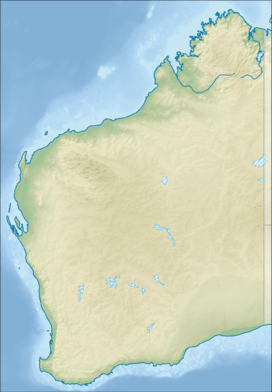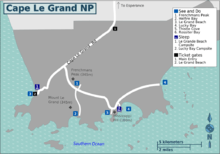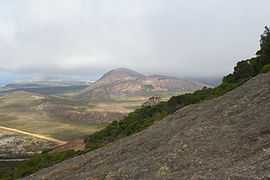Cape Le Grand National Park
| Cape Le Grand National Park Western Australia | |
|---|---|
|
IUCN category II (national park) | |
|
Mount Le Grand from Frenchman Peak | |
 Cape Le Grand National Park | |
| Nearest town or city | Esperance |
| Coordinates | 33°56′49″S 122°09′20″E / 33.94694°S 122.15556°ECoordinates: 33°56′49″S 122°09′20″E / 33.94694°S 122.15556°E |
| Established | 1966 |
| Area | 318.01 km2 (122.8 sq mi)[1] |
| Managing authorities | Department of Environment and Conservation |
| Website | Cape Le Grand National Park |
| See also |
List of protected areas of Western Australia |


Cape Le Grand National Park is a national park in Western Australia, 631 km (392 mi) south-east of Perth and 56 km (35 mi) east of Esperance. The park covers an area of 31,801 hectares (78,580 acres)
The area is an ancient landscape which has been above sea level for well over 200 million years and remained unglaciated. As a result, the area is home to many primitive relict species.[2]
Established in 1966, the park is managed by the Department of Environment and Conservation.
The name Le Grand is from one of the officers on L'Esperance, one of the ships in the 1792 expedition of Bruni d'Entrecasteaux.[3]
Geography
The largely granite shoreline and white sand beaches are picturesque features of the area. The park is a used for fishing, off-roading, tourism, and hiking.
Beaches within the Park include those at Lucky Bay, Rossiter Bay, Hellfire Bay, Le Grand Beach, and Thistle Cove.
The islands and waters to the south of the park are known as the Recherche Archipelago Nature Reserve, another protected area of the Recherche Archipelago and nearby coastal regions. The Cape Arid National Park is located to the east.
The south-west section of the Park is dominated by rock outcrops of gneiss and granite. These form a distinctive chain of peaks including Mount Le Grand (345 m), Frenchman Peak (262 m) and Mississippi Hill (180 m). Further inland, the park comprises mostly heath-covered sandplain, interspersed with swamps and pools of fresh water.
Wildlife
The sandplains support dense stands of banksias (Banksia speciosa and Banksia pulchella).[4]
Other flora that can be found around the park include Melaleucas, Grevilleas, sheoaks,[5] Christmas tree and grass trees.
Wildflowers bloom in spring lasting until October and species such as blue china orchid, Diuris corymbosa, Hakea laurina, Thysanotus sparteus and Thelymitra macrophylla are represented within the park.
Fauna that are commonly found within the park include bandicoots, pygmy honey possums, ring tailed possums, quenda and western grey kangaroos.[6]
Some of the relic species with strong gondwanan associations that are found within the park include legless lizards like the common scaly-foot, Delma fraseri, Delma australis and Aprasia striolata. The ancient but non-gondwanan blind snake Ramphotyphlops australis is also found within the park.
Endemic frogs found within the area include the quacking frog, the western banjo frog and the humming frog.
Facilities
Facilities include toilets, barbecues, campsites, tables, sheltered areas, walk-trails, information bays and water tanks. Two full-time rangers are resident within the park.[3]
Gallery
-

Overlooking Lucky Bay, one of the beaches at Cape Le Grand
-

Lucky Bay is a popular destination for tourists
-

Frenchman Peak
See also
| Wikimedia Commons has media related to Cape Le Grand National Park. |
- Protected areas of Western Australia
References
- ↑ "Department of Environment and Conservation 2009–2010 Annual Report". Department of Environment and Conservation. 2010. p. 48. ISSN 1835-114X.
- ↑ "Cape Le Grand National Park (entry AHD9816)". Australian Heritage Database. Department of Sustainability, Environment, Water, Population and Communities. 2010. Retrieved 21 November 2010.
- ↑ 3.0 3.1 "Cape Le Grande". Australian National Parks. 2008. Retrieved 2 May 2010.
- ↑ "Cape Le Grande National Park". Park Finder. 2007. Retrieved 13 May 2007.
- ↑ "Cape Le Grand National Park - Western Australia". Come Travel Australia. 2007. Retrieved 2 May 2010.
- ↑ "Esperance Trail Map" (PDF). 2009. Retrieved 2 May 2010.
